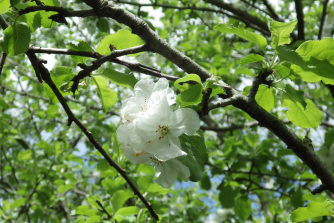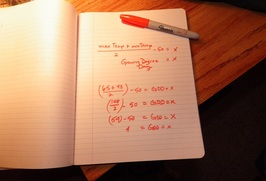 Apple blossom, 10:22 am, May 18, 2014 Apple blossom, 10:22 am, May 18, 2014 Spring blossoms are a moving target. It's not quite possible to pin them to a specific date in advance. During the winter, sadly, one cannot jot down that on March 23 "daffodil buds will open" or, "lilacs will be in full bloom in time for wedding party on May 9." Some winters are harder, some last longer, and Mother Nature sets her own schedule. Of course, there's a horticultural work-around. It's called the "growing degree day (GDD) unit," and it's offers a fairly exact timer for when the flowers will arrive. Also, when the bugs will arrive, but let's put that aside a moment. I find it cosmically reassuring to know that plants take a linear approach to growth. Frosts and floods and drought aside, plants start growing and then chug along at a steady rate. Year in and year out, plants reliably bloom after a specific number of GDDs. That formula? Starting on March 1 (in the Northern Hemisphere, for New York State anyhow), take a mean temperature of every day the temps reach 50° F, and then subtract fifty. That number accumulates -- no need to subtract chilly days.  Why, as I live and breathe, it's algebra. Algebra! Why, as I live and breathe, it's algebra. Algebra! It looks like this: (max Temp + min Temp) ÷ 2 – 50 = Growing Degree Day. For example, a low of 43 at night, and a high of 65 results in 4 GDDs. A crazy hot day can really speed things along: a high of 85 and low of 60 adds a whopping 21 GDDs to the seasonal total. This magical number DOES depend on the weather, so it's not a long-term predictor, but still, I am always glad to see evidence that chaos does not rule. It's possible to browse various cooperative extension publications and discover that forsythia needs 12 GDDs to start with its yellow blossoms, while "Spring Snow" crabapple will bloom after 209 GDDs...or that adult mosquitoes start doing their thing at 112 GDDs. Which tells us how long it takes spring to spring. Which I hope is happening at the Would-Be Farm.
6 Comments
cathmason
3/24/2015 01:36:01 am
fascinating information, love the algebra comment and the pictures.
Reply
Amy
3/24/2015 06:34:39 am
Thank you Cath!
Reply
Randy
3/24/2015 07:38:18 am
Based on the SkanCam which is fairly close to your area of NY, I'd say there's much greening going on yet. Be hopeful.
Reply
Amy
3/25/2015 06:21:08 am
Hey Randy
Reply
Greg
3/24/2015 02:20:35 pm
we just use the farmers almanac. cuts out the higher math. That was interesting, I'd forgotten about the GDD's. use mostly length of daylight myself or ground temp.
Reply
Amy
3/25/2015 06:19:22 am
I love the Farmers Almanac -- I just feel like the variation between fifty or so miles in the North Country is huge. Lake effect, altitude, even the amount of rocky outcroppings makes a big difference...
Reply
Leave a Reply. |
About the Blog
A lot of ground gets covered on this blog -- from sailboat racing to book suggestions to plain old piffle. FollowTrying to keep track? Follow me on Facebook or Twitter or if you use an aggregator, click the RSS option below.
Old school? Sign up for the newsletter and I'll shoot you a short e-mail when there's something new.
Archives
June 2024
Categories
All
|
 RSS Feed
RSS Feed
